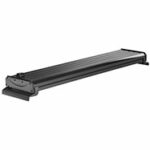How To Set Up a Convict Cichlid Tank
Setting up a convict cichlid tank is so satisfying. Having complete control over every detail often makes fish pets a little simpler than caring for a furry friend. It’s no wonder having an aquarium at home can lower your stress and blood pressure.

Convict cichlid fish are native to Central America. The Convict Cichlid are know to be most aggressive in the cichlid family.
But you should still do your research before bringing any fish home. A simple oversight like the wrong decorations or tank size can cause strife for you and your fish.
That’s why we put together this guide on how to set up a convict cichlid tank. By the time you’re done reading, you’ll know everything needed to maintain a conflict-free, convict cichlid tank.
What Size Tank Do Convict Cichlids Need?
With convict cichlid care, convict cichlid tank mates need a 20 - gallon tank for one fish, on average. But you also need to consider the bigger picture. Though semi-aggressive, convict cichlids experience stress when they’re alone.
Starting with a pair will make your fish much happier and more active. So, the perfect convict cichlid tank size for two fish is 30 gallons.
Finally, think about the max size of these fish. Males can grow to be around six inches long, while females average about four inches. Convict mates for convict cichlids will be happiest with a long tank, not a tall tank.
What Do Convict Cichlids Need in Their Tank?
Convict cichlids will need the following in their tank:
- Heater to maintain body temperature
- Substrate they can safely root around in and explore
- Lights to help plants grow
- Filter to remove harmful ammonia and nitrates
- Decoration and vegetation to create many hiding spots
- Water quality pH between 6.5 – 8.5
- Food, ideally twice a day
Next, let’s dive into why these items are important. We’ll also share our top recommendations for every item on your shopping list.
Heater
A heater is one of the most important parts of your tank mates for convict cichlids tank setup. These fish need a tank temperature between 79–84 degrees Fahrenheit. The easiest and cheapest way to achieve this is with a tank heater.
We love the Aqueon Pro 150 Submersible Aquarium Heater. Because it’s suitable for tanks up to 55 gallons, you’ll still be able to use it if you decide to get a bigger tank in the future.
You might also want an aquarium strip thermometer, which makes it easier to ensure your tank stays in the right temperature range.
Substrate
It’s common for convict cichlids to dig around the bottom of the tank. So sand is a better choice than gravel substrate.
But what if your substrate could also help maintain the pH of your tank? That’s exactly what happens when you use CaribSea Aragonite Aquarium Sand. Aragonite is known for being a great pH buffer.
Even better, this sand is high-density so it settles fast and it’s easy to clean.
Lights
The lights on your tank help your plants grow, especially if your tank isn’t located near natural light. They also allow you to see and appreciate your fishy friends.
We always use the Aqueon Modular 24″ LED Aquarium Lighting System for our aquariums. This set is priced well, easy to set up and long-lasting. It’s also modular, so you can always add another piece if you switch later to a bigger tank.
Filter
Convict cichlids are sensitive to water pH, ammonia and nitrate levels. Adding a filter will keep your fish healthier and you’ll have to do less tank maintenance.
The Marineland Bio-Wheel Power Filter is suitable for tanks up to 50 gallons. Because cichlids like to root around in the substrate, it’s imperative to keep their tank clean. This filter does the job perfectly.
Decoration and Vegetation

Convict cichlids are aggressive. The more nooks and crannies you create with caves, rocks and plants, the better.
These Cichlid Aquarium Stone Caves are a great choice. For a completely organic option, SunGrow coconut shell caves look great in any tank, too.
Water
Your tank should maintain a pH scale of 6.5–7.0. Ammonia levels need to stay low, too, as this species is very sensitive. Testing your water occasionally is the best way to stay on top of things.
Tetra EasyStrips 6-in-1 will test your water for high pH, chlorine, nitrates, nitrites, hardness and alkalinity. The results will demonstrate exactly what you need to adjust in your tank, if anything.
Food
When it comes to convict cichlid food, ours love TetraCichlid Cichlid Crisps. They contain all the nutrition your fish will need daily. You can also give them Omega One freeze-dried blood worms as a treat now and then.
Convict cichlids love to eat and they’ll overeat if you let them. Feed them twice daily, and don’t give them more than they can eat in 1–3 minutes.
FAQs
Do convict cichlids need caves?
Most convict cichlids are happiest when they have a cave, crevice or small nook to call their own. These fish are also known for being aggressive. Unless two cichlids have become a couple, they won’t share a cave.
In the wild, females lay their eggs in small caves or crevices. If you plan on breeding yours, it’s especially important to place caves or rocks in the tank.
Do convict cichlids need a heater?
Yes, your convict cichlids will most likely need a heater. If your home's temperature is between 79-84 degrees Fahrenheit, you don't need a heat source for your convict cichlid tank.
But considering the average home temperature is around 68 degrees F, you’ll probably need a heater.
How aggressive are convict cichlids?
You’ll have to contend with convict cichlid aggression in your tank. Even if you only have one male and one female, the male may be too aggressive.
But there are steps you can take to help everyone get along.
The more nooks and crannies you create, the more hiding spots for each fish. This reduces the odds of territory squabbles. If your tank is big enough for everybody, the inhabitants should stay fairly harmonious.
How big should the tank be for one convict cichlid?
You’ll want at least a 20 - gallon tank for one convict cichlid. Make sure the tank’s dimensions allow your fish to turn any direction without bumping against the walls.
And remember, these fish do better in pairs. For a pair of adult convict cichlids, a 30 - gallon tank is perfect.
What fish can live with convict cichlids?
The best convict cichlid tank mates include:
- Oscar fish. Because both species are slightly aggressive, they can co-exist well. Raising both together from juvenile age can help them get along. They mainly eat meaty foods most commonly known as small whole fishes. Oscar fish are found all over South American.
- Firemouth cichlids. Firemouth and convict cichlids can pair nicely in larger tanks. Even better, both species have similar tank requirements. This makes setup and maintenance simple.
- Pictus catfish. These small, docile fish also enjoy having hiding spots. Caves, rocks and crevices are an absolute must.
How many convict cichlids should be kept together?
You should keep at least two convict cichlids together. Your fish will be healthier and happier.
You can keep more than two if your tank is big enough, though. You’ll want 3–4 gallons of water per inch of fish. So, two males and two females will need a 60–80 - gallon tank (and plenty of hiding spots).
With a little forethought, your convict cichlids can happily co-exist without fighting over mates, territory or food.









